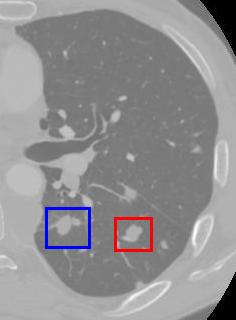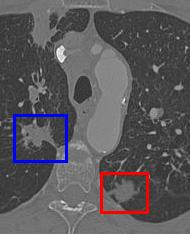Medical Image Visualization
Summary:
Computerized Tomographic (CT) imaging is used to diagnose a wide range of medical diseases. CT images give a 3-dimensional picture by detecting density differences between different features in the body. In this application, we are studying lung tumors and how to monitor their growth. Using visualization techniques, we have been able to characterize the edges of lung tumors in CT data, to get accurate measurements of tumor volume change.
Objects within the CT data, lung tumors for example, can be visualized by looking at isosurfaces within the 3-D data at isovalues equivalent to the surfaces of the tumors. We use a marching-cubes-type algorithm to produce sets of polygons to visualize these surfaces. An isosurface is determined in each voxel of the grid. (A voxel is a specific point in a CT image, similar to a pixel in a digitized image.) A linear approximation leads to triangular surfaces for visualization and a second order approximation leads to accurate tumor volume calculations for each voxel.
A 3D volume rendered visualization provides information about the CT density inside or outside the chosen isosurface value. A "transfer function" maps each density value to a color and opacity, from fully opaque to fully transparent. Volume rendering is performed on a graphics processing unit (GPU), to allow real-time visualization. In addition to the polygonal isosurface discussed above, the GPU renders a box around the CT volume. Rather than render this box normally, the GPU runs a program for each pixel of the box that traces a ray through the volume to numerically integrate a composite color for everything in the volume behind that pixel.
In order to compare different techniques that measure lung tumor volume change over time, well-characterized reference data sets are necessary. Phantom lung tumors have been synthesized for this purpose, but do not provide realistic data. By characterizing lung tumor data, we have been able to insert realistic synthetic tumors into CT data to provide challenging volume measurement reference data.
Through visualization, we are able to characterize the quality of biological images. Working with cell images that were created under a variety of imaging conditions, we have defined metrics to describe image quality.
Return to
Visualization of Biological Images



